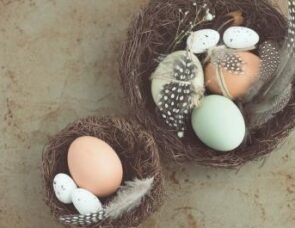This idea aims to help children identify and talk about signs of new life, respond thoughtfully to signs of new life, and understand that eggs are given at Easter because it is a time when Christians celebrate Jesus’ resurrection.

Introduction
The aims for this unit of work are that children should be able to:
- identify and talk about signs of new life
- respond thoughtfully to signs of new life
- understand that eggs are given at Easter because it is a time when Christians celebrate Jesus’ resurrection
- understand that eggs are a sign of new life
For assessment, the focus is on:
- being able to identify symbols of new life
- being able to show an illustration of new life, which forms part of a springtime celebration
- being able to explain how the symbol of new life (an egg) form part of the Christian Easter story
Development
Here is a sequence of possible activities.
Step 1: What do we mean by ‘new life’?
Walk around the school grounds and identify examples of new life such as buds opening, bulbs growing, shoots appearing etc’ Create a display – grow cress and bulbs in the classroom.
Children can then make careful drawings (using pastels to draw spring flowers in detail) and add to the display.
Discuss with the children what is happening at this time of year – ‘new life’ in the countryside.
Children could produce a spring ‘new life’ dance – i.e. children curl and stretch safely and with control, producing simple movements to show signs of new life (e.g. buds opening, shoots coming out of the ground, daffodil flowers opening etc’)
Step 2: Why is an egg an important symbol of new life?
Look at an egg and discuss the life cycle of a chicken. Talk about eggs hatching and new life, baby chicks. Or watch a video of eggs hatching. What is their reaction? How do they feel? Why do they think the egg is used as a symbol of new life?
Activities
- Make a hatching chick using card and a split pin.
- Express ideas of new life emerging from an egg by creating a sequence of movements to music.
Step 3: Why are Easter eggs given?
NB: even before Christian times, gifts of eggs were exchanged at springtime. The Greeks, Chinese and Persians all gave one another eggs to celebrate new life in nature
Show a boxed Easter egg – compare this to a normal egg. Ask questions about it. What is it? What is it for? Who uses them and why? When are they given? Why? What does it help people think about?
Show the different variety of eggs that are given.
Make papier-mache eggs and decorate with patterns/ symbols of a springtime celebration of new life.
Step 4: Why do Christian give eggs as a symbol of the Easter story?
NB: for Christians the egg became a picture of Jesus rising to new life from his dark tomb.
Read a short version of the Easter story. Link the children to ideas about new life and Christian beliefs. Explain therefore the significance of Christians giving Easter eggs.
Painted eggs that have been blown and painted wooden eggs are a popular gift at Easter in Eastern Europe in particular. There are a variety of styles and colours used that are symbolic of the meaning of Easter for Christians. For more details about these refer to web sites that carry pictures and further information on painted Easter eggs.

 Download
Download